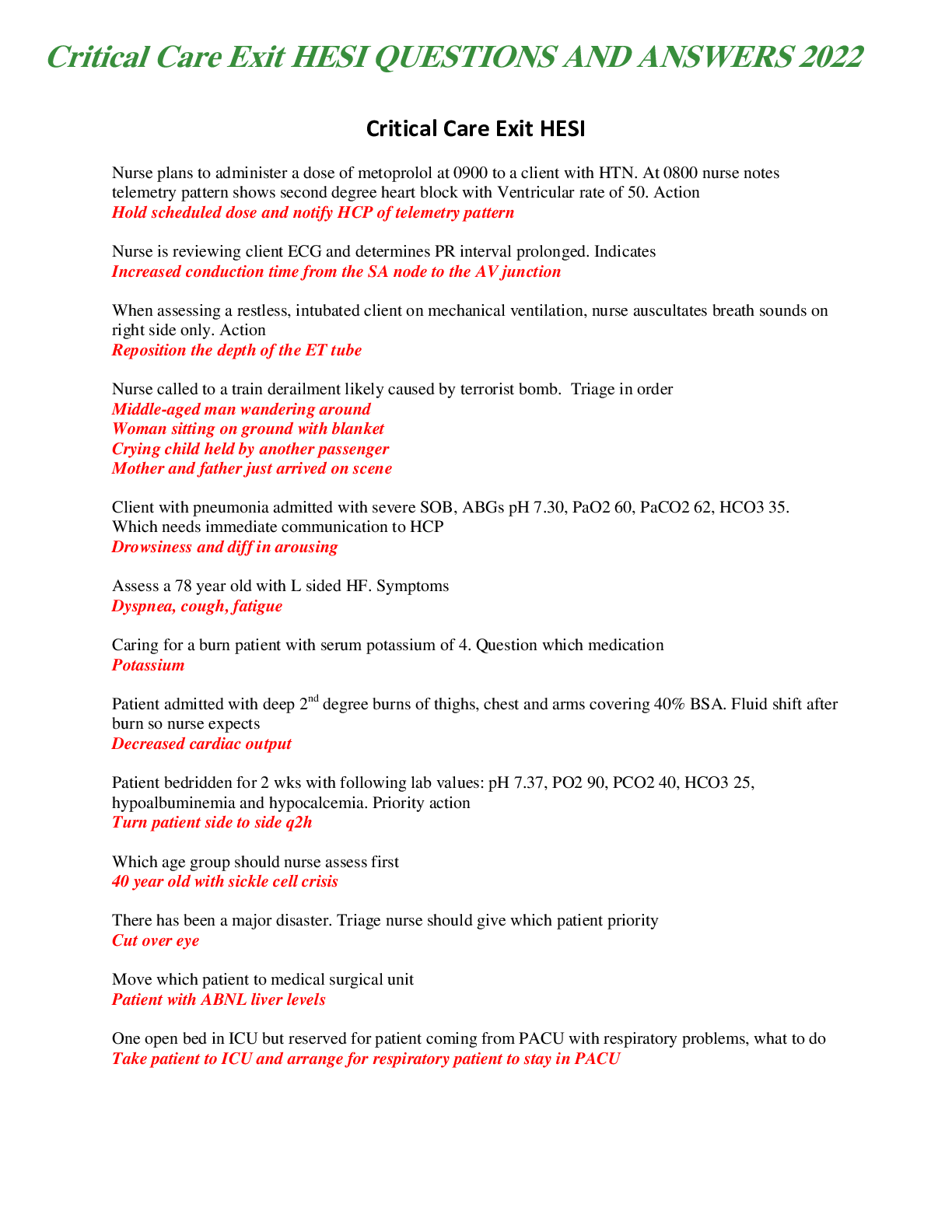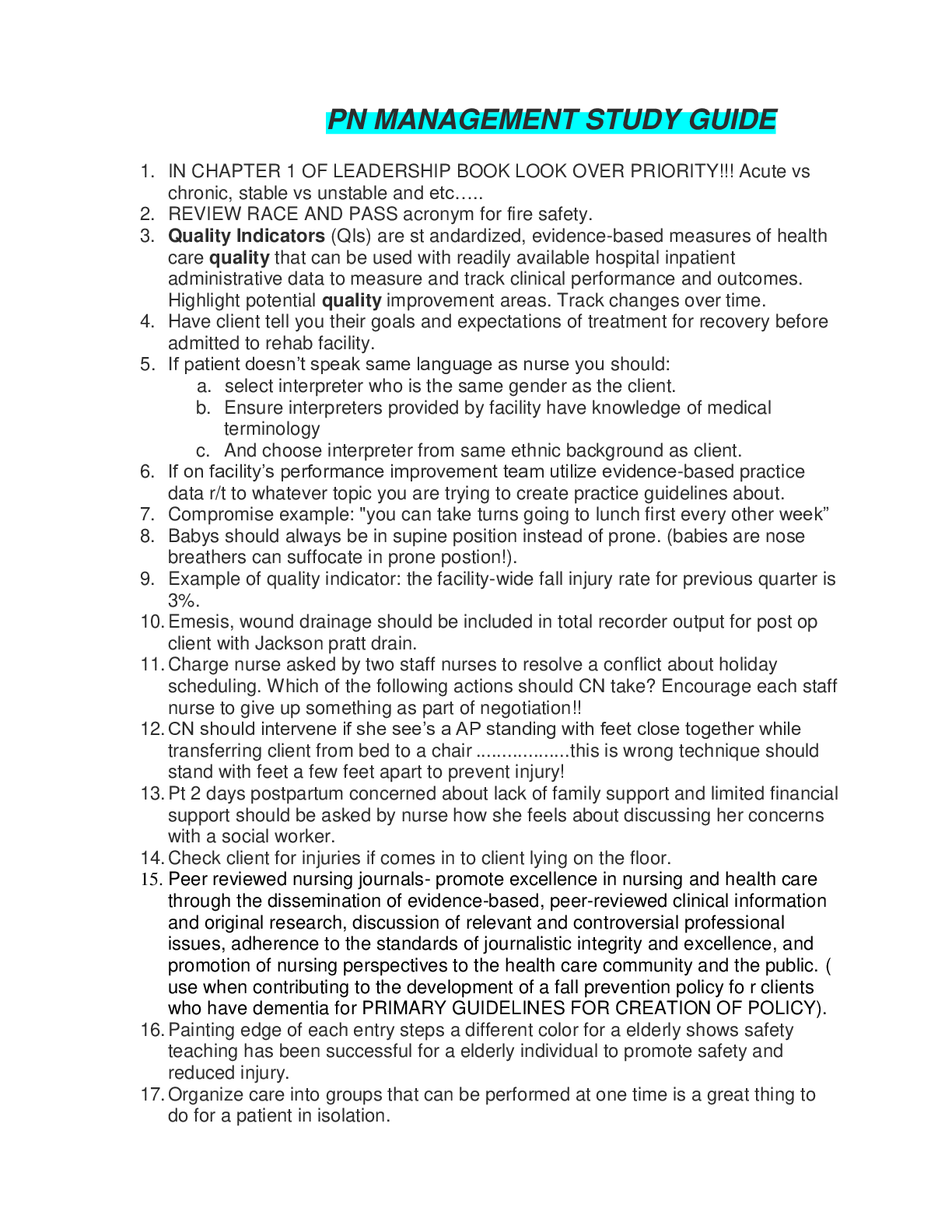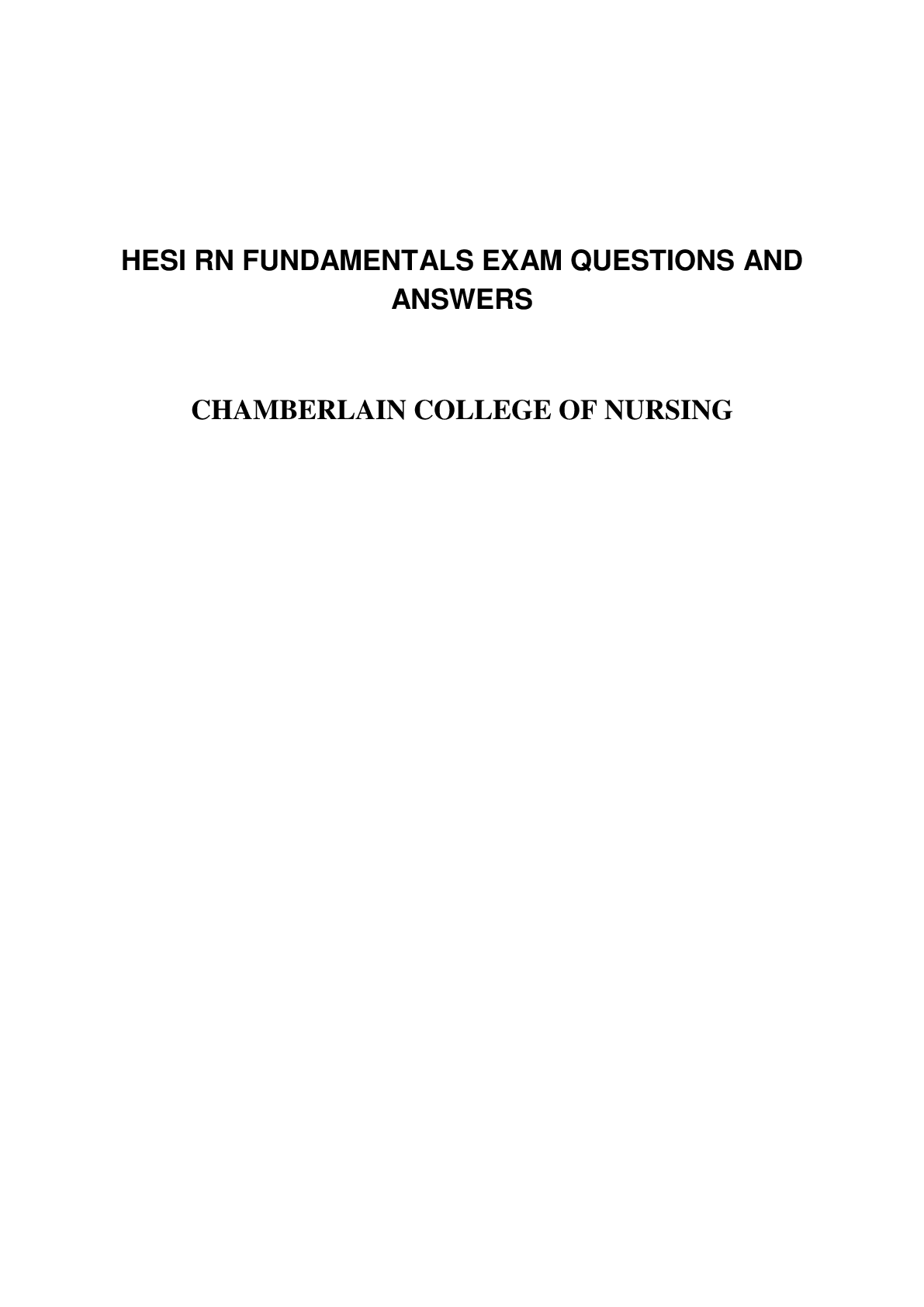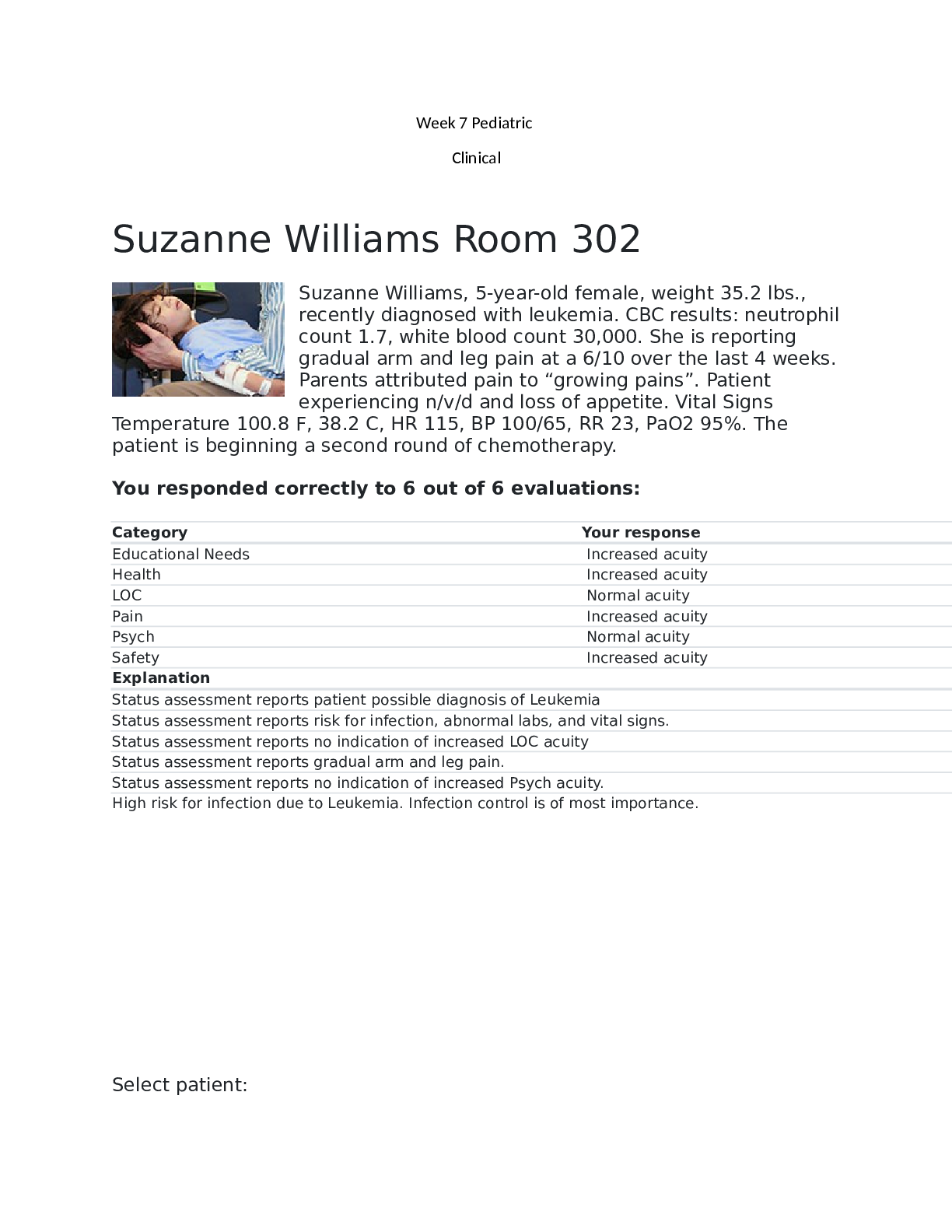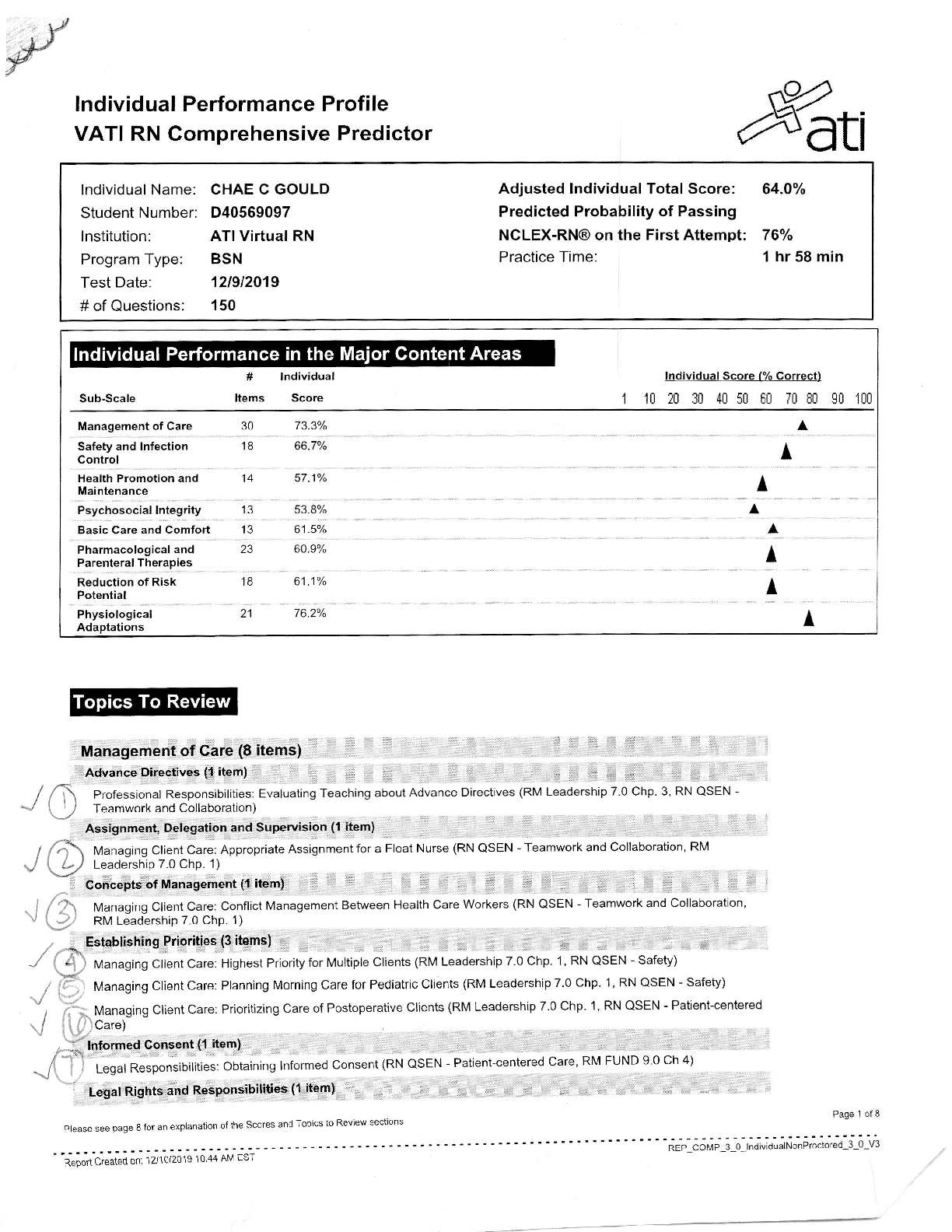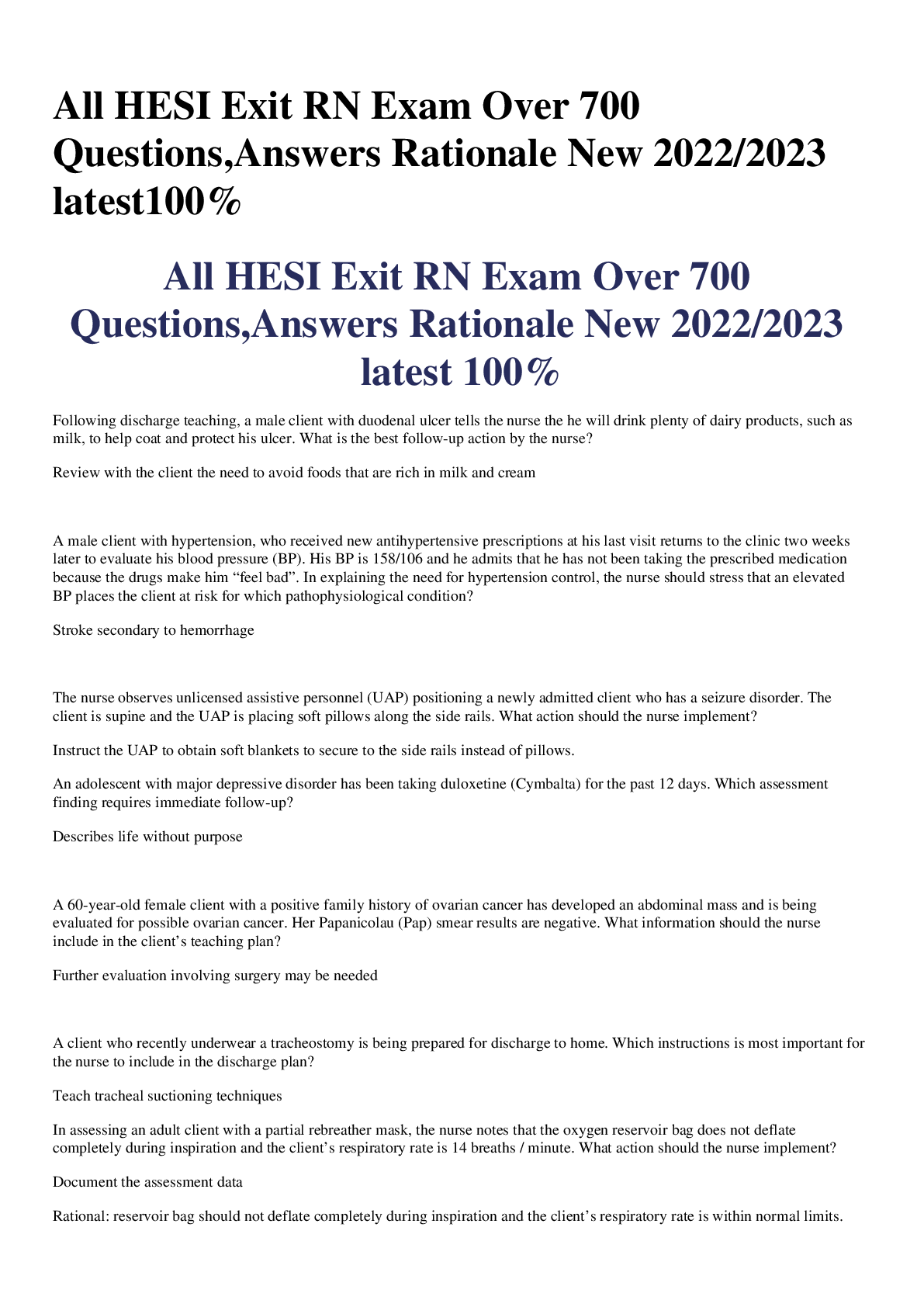*NURSING > STUDY GUIDE > HESI Exit RN Exam Over 700 Questions, Answers Rationale New 2019/2020 latest 100%. (All)
HESI Exit RN Exam Over 700 Questions, Answers Rationale New 2019/2020 latest 100%.
Document Content and Description Below
HESI Exit RN Exam Over 700 Questions new 2019 latest 100% 1. Following discharge teaching, a male client with duodenal ulcer tells the nurse the he will drink plenty of dairy products, such as milk, t... o help coat and protect his ulcer. What is the best follow-up action by the nurse. a- Remind the client that it is also important to switch to decaffeinated coffee and tea. b- Suggest that the client also plan to eat frequent small meals to reduce discomfort c- Review with the client the need to avoid foods that are rich in milk and cream. d- Reinforce this teaching by asking the client to list a dairy food that he might select. A male client with hypertension, who received new antihypertensive prescriptions at his last visit returns to the clinic two weeks later to evaluate his blood pressure (BP). His BP is 158/106 and he admits that he has not been taking the prescribed medication because the drugs make him “feel bad”. In explaining the need for hypertension control, the nurse should stress that an elevated BP places the client at risk for which pathophysiological condition? e- Blindness secondary to cataracts f- Acute kidney injury due to glomerular damage g- Stroke secondary to hemorrhage h- Heart block due to myocardial damage The nurse observes an unlicensed assistive personnel (UAP) positioning a newly admitted client who has a seizure disorder. The client is supine and the UAP is placing soft pillows along the side rails. What action should the nurse implement? a. Ensure that the UAP has placed the pillows effectively to protect the client. b. Instruct the UAP to obtain soft blankets to secure to the side rails instead of pillows. b. Assume responsibility for placing the pillows while the UAP completes another task. c. Ask the UAP to use some of the pillows to prop the client in a side lying position. An adolescent with major depressive disorder has been taking duloxetine (Cymbalta) for the past 12 days. Which assessment finding requires immediate follow-up? i- Describes life without purpose j- Complains of nausea and loss of appetite k- States is often fatigued and drowsy l- Exhibits an increase in sweating. 2. A 60-year-old female client with a positive family history of ovarian cancer has developed an abdominal mass and is being evaluated for possible ovarian cancer. Her Papanicolau (Pap) smear results are negative. What information should the nurse include in the client’s teaching plan? a- Further evaluation involving surgery may be needed b- A pelvic exam is also needed before cancer is ruled out c- Pap smear evaluation should be continued every six month d- One additional negative pap smear in six months is needed. 3. A client who recently underwear a tracheostomy is being prepared for discharge to home. Which instructions is most important for the nurse to include in the discharge plan? a- Explain how to use communication tools. b- Teach tracheal suctioning techniques c- Encourage self-care and independence. d- Demonstrate how to clean tracheostomy site. 4. In assessing an adult client with a partial rebreather mask, the nurse notes that the oxygen reservoir bag does not deflate completely during inspiration and the client’s respiratory rate is 14 breaths / minute. What action should the nurse implement? a- Encourage the client to take deep breaths b- Remove the mask to deflate the bag c- Increase the liter flow of oxygen d- Document the assessment data 5. During a home visit, the nurse observed an elderly client with diabetes slip and fall. What action should the nurse take first? a- Give the client 4 ounces of orange juice b- Call 911 to summon emergency assistance c- Check the client for lacerations or fractures d- Asses clients blood sugar level 6. At 0600 while admitting a woman for a schedule repeat cesarean section (C-Section), the client tells the nurse that she drank a cup a coffee at 0400 because she wanted to avoid getting a headache. Which action should the nurse take first? a- Ensure preoperative lab results are available b- Start prescribed IV with lactated Ringer’s c- Inform the anesthesia care provider d- Contact the client’s obstetrician. 7. After placing a stethoscope as seen in the picture, the nurse auscultates S1 and S2 heart sounds. To determine if an S3 heart sound is present, what action should the nurse take first? a- Side the stethoscope across the sternum. b- Move the stethoscope to the mitral site c- Listen with the bell at the same location d- Observe the cardiac telemetry monitor 8. A 66-year-old woman is retiring and will no longer have a health insurance through her place of employment. Which agency should the client be referred to by the employee health nurse for health insurance needs? a- Woman, Infant, and Children program b- Medicaid c- Medicare d- Consolidated Omnibus Budget Reconciliation Act provision. 9. A client who is taking an oral dose of a tetracycline complains of gastrointestinal upset. What snack should the nurse instruct the client to take with the tetracycline? a- Fruit-flavored yogurt. b- Cheese and crackers. c- Cold cereal with skim milk. d- Toasted wheat bread and jelly 10. Following a lumbar puncture, a client voices several complaints. What complaint indicated to the nurse that the client is experiencing a complication? a- “I am having pain in my lower back when I move my legs” b- “My throat hurts when I swallow” c- “I feel sick to my stomach and am going to throw up” d- I have a headache that gets worse when I sit up” 11. An elderly client seems confused and reports the onset of nausea, dysuria, and urgency with incontinence. Which action should the nurse implement? a- Auscultate for renal bruits b- Obtain a clean catch mid-stream specimen c- Use a dipstick to measure for urinary ketone d- Begin to strain the client’s urine. 12. The nurse is assisting the mother of a child with phenylketonuria (PKU) to select foods that are in keeping with the child’s dietary restrictions. Which foods are contraindicated for this child? a- Wheat products b- Foods sweetened with aspartame. c- High fat foods d- High calories foods. 13. Before preparing a client for the first surgical case of the day, a part-time scrub nurse asks the circulating nurse if a 3-minute surgical hand scrub is adequate preparation for this client. Which response should the circulating nurse provide? a- Ask a more experience nurse to perform that scrub since it is the first time of the day b- Validate the nurse is implementing the OR policy for surgical hand scrub c- Inform the nurse that hand scrubs should be 3 minutes between cases. d- Direct the nurse to continue the surgical hand scrub for a 5-minute duration. 14. Which breakfast selection indicates that the client understands the nurse’s instructions about the dietary management of osteoporosis? a- Egg whites, toast and coffee. b- Bran muffin, mixed fruits, and orange juice. c- Granola and grapefruit juice d- Bagel with jelly and skim milk. 15. The charge nurse of a critical care unit is informed at the beginning of the shift that less than the optimal number of registered nurses will be working that shift. In planning assignments, which client should receive the most care hours by a registered nurse (RN)? a- A 34-year -old admitted today after an emergency appendendectomy who has a peripheral intravenous catheter and a Foley catheter. b- A 48-year-old marathon runner with a central venous catheter who is experiencing nausea and vomiting due to electrolyte disturbance following a race. c- A 63-year-old chain smoker admitted with chronic bronchitis who is receiving oxygen via nasal cannula and has a saline-locked peripheral intravenous catheter. d- An 82-year-old client with Alzheimer’s disease newly-fractures femur who has a Foley catheter and soft wrist restrains applied 16. Z a- Cleanse the foot with soap and water and apply an antibiotic ointment b- Provide teaching about the need for a tetanus booster within the next 72 hours. c- have the mother check the child's temperature q4h for the next 24 hours d- transfer the child to the emergency department to receive a gamma globulin injection 17. The mother of an adolescent tells the clinic nurse, “My son has athlete’s foot, I have been applying triple antibiotic ointment for two days, but there has been no improvement.” What instruction should the nurse provide? a- Antibiotics take two weeks to become effective against infections such as athlete’s foot. b- Continue using the ointment for a full week, even after the symptoms disappear. c- Applying too much ointment can deter its effectiveness. Apply a thin layer to prevent maceration. d- Stop using the ointment and encourage complete drying of the feet and wearing clean socks. 18. A 26-year-old female client is admitted to the hospital for treatment of a simple goiter, and levothyroxine sodium (Synthroid) is prescribed. Which symptoms indicate to the nurse that the prescribed dosage is too high for this client? The client experiences a- Palpitations and shortness of breath b- Bradycardia and constipation c- Lethargy and lack of appetite d- Muscle cramping and dry, flushed skin 19. A client with a history of heart failure presents to the clinic with a nausea, vomiting, yellow vision and palpitations. Which finding is most important for the nurse to assess to the client? a- Determine the client’s level of orientation and cognition b- Assess distal pulses and signs of peripheral edema c- Obtain a list of medications taken for cardiac history. d- Ask the client about exposure to environmental heat. 20. The healthcare provider prescribes an IV solution of isoproterenol (Isuprel) 1 mg in 250 ml of D5W at 300 mcg/hour. The nurse should program the infusion pump to deliver how many ml/hour? (Enter numeric value only.) a- 75 21. The pathophysiological mechanisms are responsible for ascites related to liver failure? (Select all that apply) a- Bleeding that results from a decreased production of the body’s clotting factors b- Fluid shifts from intravascular to interstitial area due to decreased serum protein c- Increased hydrostatic pressure in portal circulation increases fluid shifts into abdomen d- Increased circulating aldosterone levels that increase sodium and water retention e- Decreased absorption of fatty acids in the duodenum leading to abdominal distention. 22. The nurse is auscultating a client’s heart sounds. Which description should the nurse use to document this sound? (Please listen to the audio first to select the option that applies) a- S1 S2 b- S1 S2 S3 c- Murmur d- Pericardial friction rub. 23. The healthcare provider prescribes celtazidime (Fortax) 35 mg every 8 hours IM for an infant. The 500 mg vial is labeled with the instruction to add 5.3 ml diluent to provide a concentration of 100 mg/ml. How many ml should the nurse administered for each dose? (Enter numeric value only. If rounding is required, round to the nearest tenth) a- 0.4 24. The nurse notes that a client has been receiving hydromorphone (Dilaudid) every six hours for four days. What assessment is most important for the nurse to complete? a- Auscultate the client's bowel sounds b- Observe for edema around the ankles c- Measure the client’s capillary glucose level d- Count the apical and radial pulses simultaneously 25. A female client is admitted with end stage pulmonary disease is alert, oriented, and complaining of shortness of breath. The client tells the nurse that she wants “no heroic measures” taken if she stops breathing, and she asks the nurse to document this in her medical record. What action should the nurse implement? a- Ask the client to discuss “do not resuscitate” with her healthcare provider 26. A client is receiving a full strength continuous enteral tube feeding at 50 ml/hour and has developed diarrhea. The client has a new prescription to change the feeding to half strength. What intervention should the nurse implement? a- Add equal amounts of water and feeding to a feeding bag and infuse at 50ml/hour b- Continue the full strength feeding after decreasing the rate of infusion to 25 ml/hr. c- Maintain the present feeding until diarrhea subsides and the begin the next new prescription. d- Withhold any further feeding until clarifying the prescription with healthcare provides. 27. A female client reports that her hair is becoming coarse and breaking off, that the outer part of her eyebrows have disappeared, and that her eyes are all puffy. Which follow-up question is best for the nurse to ask? a- “Is there a history of female baldness in your family?” b- “Are you under any unusual stress at home or work?” c- “Do you work with hazardous chemicals?” d- “Have you noticed any changes in your fingernails?” 28. After a third hospitalization 6 months ago, a client is admitted to the hospital with ascites and malnutrition. The client is drowsy but responding to verbal stimuli and reports recently spitting up blood. What assessment finding warrants immediate intervention by the nurse? a- Bruises on arms and legs b- Round and tight abdomen c- Pitting edema in lower legs d- Capillary refill of 8 seconds 29. After the nurse witnesses a preoperative client sign the surgical consent form, the nurse signs the form as a witness. What are the legal implications of the nurse’s signature on the client’s surgical consent form? (Select all that apply) a- The client voluntarily grants permission for the procedure to be done b- The surgeon has explained to the client why the surgery is necessary. c- The client is competent to sign the consent without impairment of judgment d- The client understands the risks and benefits associated with the procedure e- After considering alternatives to surgery, the client elects to have the procedure. 30. Following surgery, a male client with antisocial personality disorder frequently requests that a specific nurse be assigned to his care and is belligerent when another nurse is assigned. What action should the charge nurse implement? a- Ask the client to explain why he constantly request the nurse b- Encourage the client to verbalize his feelings about the nurse c- Reassure the client that his request will be met whenever possible. d- Advise the client that assignments are not based on client requests 31. A client with cervical cancer is hospitalized for insertion of a sealed internal cervical radiation implant. While providing care, the nurse finds the radiation implant in the bed. What action should the nurse take? a- Call the radiology department b- Reinsert the implant into the vagina c- Apply double gloves to retrieve the implant for disposal. d- Place the implant in a lead container using long-handled forceps 32. The client with which type of wound is most likely to need immediate intervention by the nurse? a- Laceration b- Abrasion c- Contusion d- Ulceration 33. The nurse is planning care for a client admitted with a diagnosis of pheochromocytoma. Which intervention has the highest priority for inclusion in this client’s plan of care? a- Record urine output every hour b- Monitor blood pressure frequently c- Evaluate neurological status d- Maintain seizure precautions 34. When caring for a client who has acute respiratory distress syndrome (ARDS), the nurse elevates the head of the bed 30 degrees. What is the reason for this intervention? a- To reduce abdominal pressure on the diaphragm b- to promote retraction of the intercostal accessory muscle of respiration c- to promote bronchodilation and effective airway clearance d- to decrease pressure on the medullary center which stimulates breathing 35. When assessing a mildly obese 35-year-old female client, the nurse is unable to locate the gallbladder when palpating below the liver margin at the lateral border of the rectus abdominal muscle. What is the most likely explanation for failure to locate the gallbladder by palpation? a- The client is too obese b- Palpating in the wrong abdominal quadrant c- The gallbladder is normal d- Deeper palpation technique is needed 36. A woman with an anxiety disorder calls her obstetrician’s office and tells the nurse of increased anxiety since the normal vaginal delivery of her son three weeks ago. Since she is breastfeeding, she stopped taking her antianxiety medications, but thinks she may need to start taking them again because of her increased anxiety. What response is best for the nurse to provide this woman? a- Describe the transmission of drugs to the infant through breast milk b- Encourage her to use stress relieving alternatives, such as deep breathing exercises c- Inform her that some antianxiety medications are safe to take while breastfeeding d- Explain that anxiety is a normal response for the mother of a 3-week-old. 37. An older male client with a history of type 1 diabetes has not felt well the past few days and arrives at the clinic with abdominal cramping and vomiting. He is lethargic, moderately, confused, and cannot remember when he took his last dose of insulin or ate last. What action should the nurse implement first? a- obtain a serum potassium level b- administer the client's usual dose of insulin c- assess pupillary response to light d- Start an intravenous (IV) infusion of normal saline 38. A client who received multiple antihypertensive medications experiences syncope due to a drop-in blood pressure to 70/40. What is the rationale for the nurse’s decision to hold the client’s scheduled antihypertensive medication? a- Increased urinary clearance of the multiple medications has produced diuresis and lowered the blood pressure b- The antagonistic interaction among the various blood pressure medications has reduced their effectiveness c- The additive effect of multiple medications has caused the blood pressure to drop too low. d- The synergistic effect of the multiple medications has resulted in drug toxicity and resulting hypotension. 39. Which client is at the greatest risk for developing delirium? a- An adult client who cannot sleep due to constant pain. b- an older client who attempted 1 month ago c- a young adult who takes antipsychotic medications twice a day d- a middle-aged woman who uses a tank for supplemental oxygen 40. Which intervention should the nurse include in a long-term plan of care for a client with Chronic Obstructive Pulmonary Disease (COPD)? a- Reduce risks factors for infection b- Administer high flow oxygen during sleep c- Limit fluid intake to reduce secretions d- Use diaphragmatic breathing to achieve better exhalation 41. Which location should the nurse choose as the best for beginning a screening program for hypothyroidism? a- A business and professional women's group. b- An African-American senior citizens center c- A daycare center in a Hispanic neighborhood d- An after-school center for Native-American teens 42. A female client has been taking a high dose of prednisone, a corticosteroid, for several months. After stopping the medication abruptly, the client reports feeling “very tired”. Which nursing intervention is most important for the nurse to implement? a- Measure vital signs b- Auscultate breath sounds c- Palpate the abdomen d- Observe the skin for bruising 43. A male client reports the onset of numbness and tingling in his fingers and around his mouth. Which lab is important for the nurse to review before contacting the health care provider? a- capillary glucose b- urine specific gravity c- Serum calcium d- white blood cell count 44. What explanation is best for the nurse to provide a client who asks the purpose of using the log-rolling technique for turning? a- working together can decrease the risk for back injury b- The technique is intended to maintain straight spinal alignment. c- Using two or three people increases client safety. d- turning instead of pulling reduces the likelihood of skin damage 45. A client receiving chemotherapy has severe neutropenia. Which snack is best for the nurse to recommend to the client? a- Plain yogurt with sweetened with raw honey b- Peanuts in the shell, roasted or un-roasted. c- Aged farmer’s cheese with celery sticks d- Baked apples topped with dried raisins 46. Which action should the school nurse take first when conducting a screening for scoliosis? a- Compare dorsal measurement of trunk b- Extend arms over head for visualization c- Inspect for symmetrical shoulder height. d- Observe weight-bearing on each leg. 47. An unlicensed assistive personnel (UAP) assigned to obtain client vital signs reports to the charge nurse that a client has a weak pulse with a rate of 44 beat/ minutes. What action should the charge nurse implement? a- Instruct the UAP to count the client apical pulse rate for sixty seconds b- Determine if the UAP also measured the client’s capillary refill time. c- Assign a practical nurse (LPN) to determine if an apical radial deficit is present. d- Notify the health care provider of the abnormal pulse rate and pulse volume. 48. After a sudden loss of consciousness, a female client is taken to the ED and initial assessment indicate that her blood glucose level is critically low. Once her glucose level is stabilized, the client reports that was recently diagnosed with anorexia nervosa and is being treated at an outpatient clinic. Which intervention is more important to include in this client’s discharge plan? a- Describe the signs and symptoms of hypoglycemia. b- Encourage a low-carbohydrate and high-protein diet c- Reinforce the need to continue outpatient treatment d- Suggest wearing a medical alert bracelet at all time. 53- A client with a peripherally inserted central catheter (PICC) line has a fever. What client assessment is most important for the nurse to perform? a- Observe the antecubital fossa for inflammation. 54- The nurse administers an antibiotic to a client with respiratory tract infection. To evaluate the medication’s effectiveness, which laboratory values should the nurse monitor? Select all that apply a- White blood cell (WBC) count b- Sputum culture and sensitivity 55- A client is admitted to isolation with the diagnosis of active tuberculosis. Which infection control measures should the nurse implement? a- Negative pressure environment b- contact precautions c- droplet precautions d- protective environment 56- A school nurse is called to the soccer field because a child has a nose bleed (epistaxis). In what position should the nurse place the child? a- Sitting up and leaning forward 57- A young adult who is hit with a baseball bat on the temporal area of the left skull is conscious when admitted to the ED and is transferred to the Neurological Unit to be monitored for signs of closed head injury. Which assessment finding is indicative of a developing epidural hematoma? a- Altered consciousness within the first 24 hours after injury. 58- A female client with breast cancer who completed her first chemotherapy treatment today at an out-patient center is preparing for discharge. Which behavior indicates that the client understands her care needs a- Rented movies and borrowed books to use while passing time at home 59- Which instruction should the nurse provide a pregnant client who is complaining of heartburn? a- Limit fluids between meals to avoid over distension of the stomach b- Take an antacid at bedtime and whenever symptoms worsen c- Maintain a sitting position for two hours after eating. d- Eat small meal throughout the day to avoid a full stomach. 60- A client is admitted to the intensive care unit with diabetes insipidus due to a pituitary gland tumor. Which potential complication should the nurse monitor closely? a- Hypokalemia b- Ketonuria. c- Peripheral edema d- Elevated blood pressure 61- A female client reports she has not had a bowel movement for 3 days, but now is defecating frequent small amount of liquid stool. Which action should the nurse implement? a- Digitally check the client for a fecal impaction 62- After changing to a new brand of laundry detergent, an adult male report that he has a fine itchy rash. Which assessment finding warrants immediate intervention by the nurse? a- Bilateral Wheezing. 63- The nurse should teach the parents of a 6 year-old recently diagnosed with asthma that the symptom of acute episode of asthma are due to which physiological response? a- Inflammation of the mucous membrane & bronchospasm 64- A 10-year-old who has terminal brain cancer asks the nurse, "What will happen to my body when I die?" How should the nurse respond? a- "The heart will stop beating & you will stop breathing." 65- The nurse is assessing a 3-month-old infant who had a pylorotomy yesterday. This child should be medicated for pain based on which findings? Select all that apply: a- Restlessness b- Clenched Fist (puño cerrado) c- Increased pulse rate d- Increased respiratory rate. e- Increased temperature f- Peripheral pallor of the skin 66- The nurse is preparing to administer an oral antibiotic to a client with unilateral weakness, ptosis, mouth drooping and, aspiration pneumonia. What is the priority nursing assessment that should be done before administering this medication? a- Ask the client about soft foods preferences b- Auscultate the client’s breath sounds c- Obtain and record the client’s vital signs d- Determine which side of the body is weak. 67- The nurse who is working on a surgical unit receives change of shift report on a group of clients for the upcoming shift. A client with which condition requires the most immediate attention by the nurse? a- Gunshot wound three hours ago with dark drainage of 2 cm noted on the dressing. b- Mastectomy 2 days ago with 50 ml bloody drainage noted in the Jackson-pratt drain. c- Collapsed lung after a fall 8h ago with 100 ml blood in the chest tube collection container d- Abdominal-perineal resection 2 days ago with no drainage on dressing who has fever and chills. 68- The nurse is caring for a client who had gastric bypass surgery yesterday. Which intervention is most important for the nurse to implement during the first 24 postoperative hours? a- Insert an indwelling urinary catheter b- Monitor for the appearance of an incisional hernia c- Instruct the client to eat small frequent meals d- Measure hourly urinary output. 69- When preparing to discharge a male client who has been hospitalized for an adrenal crisis, the client expresses concern about having another crisis. He tells the nurse that he wants to stay in the hospital a few more days. Which intervention should the nurse implement? a- Administer anti=anxiety medication prior to providing discharge instructions b- Schedule an appointment for an out-patient psychosocial assessment. c- Obtain a blood cortisol level after last dose of synthetic ACTH d- Encourage the healthcare provider to delay the client’s discharge. 70- An adult female client tells the nurse that though she is afraid her abusive boyfriend might one-day kill her, she keeps hoping that he will change. What action should the nurse take first? a- Report the finding to the police department b- Discuss treatment options for abusive partners c- Determine the frequency and type of client’s abuse d- Explore client’s readiness to discuss the situation. 71- In caring for a client with Cushing syndrome, which serum laboratory value is most important for the nurse to monitor? a- Lactate b- Glucose c- Hemoglobin d- Creatinine 72- Azithromycin is prescribed for an adolescent female who has lower lobe pneumonia and recurrent chlamydia. What information is most important for the nurse to provide to this client? a- Have partner screened for human immunodeficiency virus b- Report a sudden onset arthralgia to the healthcare provider c- Decrease intake of high-fat-foods, caffeine, and alcohol d- Use two forms of contraception while taking this drug. 73- A client in the emergency center demonstrates rapid speech, flight of ideas, and reports sleeping only three hours during the past 48h. Based on these finding, it is most important for the nurse to review the laboratory value for which medication? a- Olanzapine b- Divalproex. c- Lorazepam d- Fluoxetine 74- A male client who is admitted to the mental health unit for treatment of bipolar disorder has a slightly slurred speech pattern and an unsteady gait. Which assessment finding is most important for the nurse to report to the healthcare provider? a- Blood alcohol level of 0.09% b- Serum lithium level of 1.6 mEq/L or mmol/l (SI) c- Six hours of sleep in the past three days. d- Weight loss of 10 pounds (4.5 kg) in past month. 75- A client was admitted to the cardiac observation unit 2 hours ago complaining of chest pain. On admission, the client’s EKG showed bradycardia, ST depression, but no ventricular ectopy. The client suddenly reports a sharp increase in pain, telling the nurse, “I feel like an elephant just stepped on my chest” The EKG now shows Q waves and ST segment elevations in the anterior leads. What intervention should the nurse perform? a- Increase the peripheral IV flow rate to 175 ml/hr to prevent hypotension and shock b- Administer prescribed morphine sulfate IV and provide oxygen at 2 L/min per nasal cannula. c- Obtain a stat 12 lead EKG and perform a venipuncture to check cardiac enzymes levels. d- Notify the healthcare provider of the client’s increase chest pain a call for the defibrillator crash cart. 76- The nurse is developing a teaching program for the community. What population characteristic is most influential when choosing strategies for implementing a teaching plan? a- Literacy level b- Prevalent learning style c- Median age d- Percent with internet access. 77- A client is being discharged with a prescription for warfarin (Coumadin). What instruction should the nurse provide this client regarding diet? a- Eat approximated the same amount of leafy green vegetables daily so the amount of vitamin K consumed is consistent. b- Avoid eating all foods that contain any vitamin K because it is an antagonist of Coumadin. c- Increase the intake of dark green leafy vegetables while taking Coumadin d- Eat two servings of raw dark green leafy vegetables daily and continue for 30 days after Coumadin therapy is completed. 78- A client who had a small bowel resection acquired methicillin resistant staphylococcus aureus (MRSA) while hospitalized. He treated and released but is readmitted today because of diarrhea and dehydration. It is most important for the nurse to implement which intervention. a- Maintain contact transmission precaution b- Review white blood cell (WBC) count daily c- Instruct visitors to gown and wash hands d- Collect serial stool specimens for culture 79- A postoperative female client has a prescription for morphine sulfate 10 mg IV q3 hours for pain. One dose of morphine was administered when the client was admitted to the post anesthesia care unit (PACU) and 3 hours later, the client is again complaining of pain. Her current respiratory rate is 8 breaths/minute. What action should the nurse take? a- Provide oxygen 100% via facemask b- Check peripheral tendon reflexes c- Give another IV dose of morphine d- Administer Naloxone IV 80- Which intervention is most important for the nurse to include in the plan of care for an older woman with osteoporosis? a- Evaluate the client’s orientation to time and place b- Place the client on fall precautions c- Encourage the client to drink milk with meals d- Assess the client’s breath sounds daily. 81- Based on the information provided in this client’s medical record during labor, which should the nurse implement? (Click on each chart tab for additional information. Please be sure to scroll to the bottom right corner of each tab to view all information contained in the client’s medical record) a- Apply oxygen 10 l/mask b- Stop the oxytocin infusion c- Turn the client to the right lateral position. d- Continue to monitor the progress of labor. 82- An unlicensed assistive personnel UAP leaves the unit without notifying the staff. In what order should the unit manager implement this intervention to address the UAPs behavior? (Place the action in order from first on top to last on bottom.) 1. Note date and time of the behavior. 2. Discuss the issue privately with the UAP. 3. Plan for scheduled break times. 4. Evaluate the UAP for signs of improvement. 83- A client with intestinal obstructions has a nasogastric tube to low intermittent suction and is receiving an IV of lactated Ringer’s at 100 ml/H. which finding is most important for the nurse to report to the healthcare provider? a- Gastric output of 900 mL in the last 24 hours b- Serum potassium level of 3.1 mEq/L or mmol/L (SI) c- Increased blood urea nitrogen (BUN) d- 24-hour intake at the current infusion rate. 84- Which type of Leukocyte is involved with allergic responses and the destruction of parasitic worms? a- Neutrophils b- Lymphocytes c- Eosinophils d- Monocytes 85- Several months after a foot injury, and adult woman is diagnosed with neuropathic pain. The client describes the pain as severe and burning and is unable to put weight on her foot. She asks the nurse when the pain will “finally go away.” How should the nurse respond? a- Explain the healing from injury can take many months b- Assist the client in developing a goal of managing the pain. c- Encourage the client to verbalize her fears about the pain d- Complete an assessment of the client’s functional ability. 86- One day following an open reduction and internal fixation of a compound fracture of the leg, a male client complains of “a tingly sensation” in his left foot. The nurse determines the client’s left pedal pulses are diminished. Based on these finding, what is the client’s greatest risk? a- Reduce pulmonary ventilation and oxygenation related to fat embolism. b- Neurovascular and circulation compromise related to compartment syndrome. c- Wound infection and delayed healing to fractured bone protrusion. d- Venous stasis and thrombophlebitis related to postoperative immobility. 87- The nurse is completing a head to be assessment for a client admitted for observation after falling out of a tree. Which finding warrants immediate intervention by the nurse? a- Sluggish pupillary response to light b- Clear fluid leaking from the nose. c- Complaint of severe headache [Show More]
Last updated: 2 years ago
Preview 1 out of 300 pages

Buy this document to get the full access instantly
Instant Download Access after purchase
Buy NowInstant download
We Accept:

Reviews( 0 )
$16.50
Can't find what you want? Try our AI powered Search
Document information
Connected school, study & course
About the document
Uploaded On
Dec 30, 2020
Number of pages
300
Written in
Additional information
This document has been written for:
Uploaded
Dec 30, 2020
Downloads
1
Views
282





